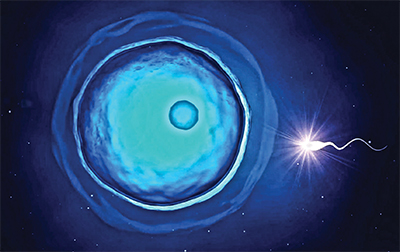MCP: Sperm-quality study updates advice for couples
Could doctors at fertility clinics be giving men bad advice? Two clinician–researchers at the Center for Reproductive Medicine of Shengjing Hospital in Shenyang, China, think so.
Research from Da Li and XiuXia Wang’s labs, published in the journal Molecular & Cellular Proteomics, upends conventional wisdom that abstaining between efforts to conceive can improve a couple’s chances of success. The research team worked with almost 500 couples to test whether how long a couple waits between efforts to conceive could change their success rate.
 An artist’s representation of fertilization of an oocyte by a sperm cell.Courtesy of Karl-Ludwig Poggemann/Flickr
An artist’s representation of fertilization of an oocyte by a sperm cell.Courtesy of Karl-Ludwig Poggemann/Flickr
“For years, men have usually been advised to limit sexual activity to increase the chances of pregnancy,” said Li. “However, it’s time to change our minds.”
Some earlier studies had shown that semen produced shortly after a man’s most recent ejaculation — within three hours or so — had faster and more motile sperm than if the man abstained for several days before ejaculating again. But it wasn’t clear why the sperm changed or whether the changes affected fertility. So researchers set up a few side-by-side experiments.
They looked at individual subjects’ semen after they had abstained for either several days or just an hour or two, comparing the volume of semen and the mobility of sperm. As had been observed earlier, the sperm from shorter abstinence periods moved faster.
Using mass spectrometry to look at the protein makeup of the samples, the team found major molecular differences. The majority of the affected proteins were involved in cell adhesion, a function that sperm need in order to fuse with egg cells.
The team also observed changes to proteins involved in sperm motility and metabolism, especially proteins that handle reactive oxygen species, a byproduct of cellular energy production. Although reactive oxygen species are needed for some normal sperm functions, an excess can damage sperm’s genetic material.
According to Li and Wang’s results, the longer sperm exist, the more vulnerable they are to DNA damage by reactive oxygen, which could harm their ability to form a viable embryo.
To see whether the changes to sperm were affecting fertility, the research team also ran a study of about 500 couples preparing for in vitro fertilization at the fertility clinic. They asked men in the control group for semen samples after several days of abstinence, whereas men in the experimental group abstained for less than three hours before providing their samples. The IVF team proceeded as usual with the two types of sample, using them to generate and then implant embryos.
“A typical live birth rate in a cohort of this size is about 30 percent,” Li said. In the experimental cohort, live births were higher by one-third.
“Our data indicate that couples with relatively normal semen parameters should have frequent sex around the ovulation period,” Li said. “This could make all the difference to their efforts to start a family.”
Meanwhile, IVF treatments at the Center for Reproductive Medicine, which treats about 5,000 infertile couples per year, also are being updated to use semen from more closely spaced ejaculations.
The team plans to continue working with patients, Li said, and will investigate differences in post-translational modifications that his lab saw between the types of samples. “This is a very new field,” he said, noting that there are many unanswered questions about the changes the team observed.
Enjoy reading ASBMB Today?
Become a member to receive the print edition monthly and the digital edition weekly.
Learn moreGet the latest from ASBMB Today
Enter your email address, and we’ll send you a weekly email with recent articles, interviews and more.
Latest in Science
Science highlights or most popular articles

What is metabolism
A biochemist explains how different people convert energy differently – and why that matters for your health.

What’s next in the Ozempic era
Diabetes, weight loss and now heart health: A new family of drugs is changing the way scientists are thinking about obesity — and more uses are on the horizon.

How a gene spurs tooth development
University of Iowa researchers find a clue in a rare genetic disorder’s missing chromosome.

New class of antimicrobials discovered in soil bacteria
Scientists have mined Streptomyces for antibiotics for nearly a century, but the newly identified umbrella toxin escaped notice.

New study finds potential targets at chromosome ends for degenerative disease prevention
UC Santa Cruz inventors of nanopore sequencing hail innovative use of their revolutionary genetic-reading technique.

From the journals: JLR
How lipogenesis works in liver steatosis. Removing protein aggregates from stressed cells. Linking plasma lipid profiles to cardiovascular health. Read about recent papers on these topics.

